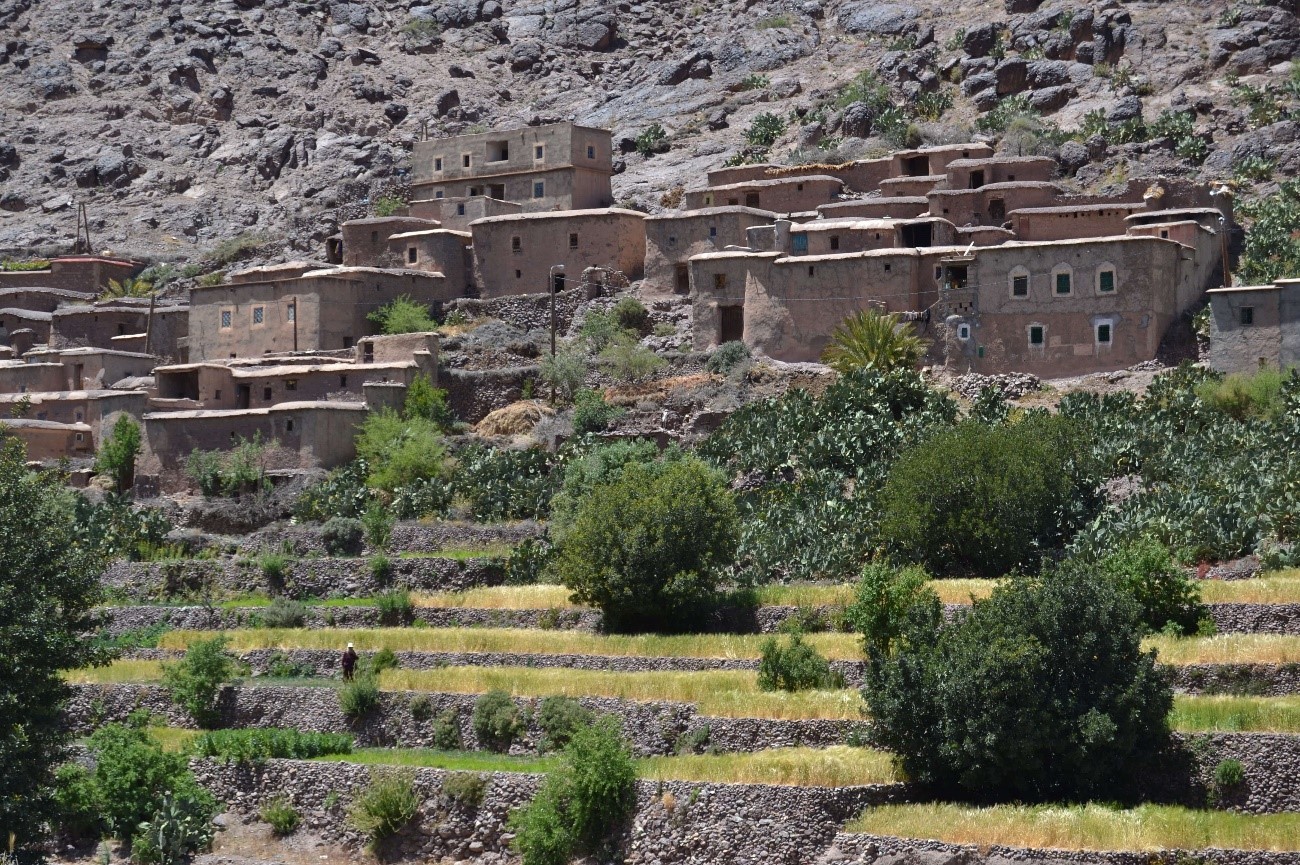
Blog: Water conflicts at desert limits: the case of the Réserve de Biosphere de l’Arganeraie (Morocco)
Today I would like to bring you closer to the past, present and future challenges of water conflicts in the Réserve de Biosphere de l’Arganeraie (Morocco). To achieve this, I interviewed Mari Carmen Romera Puga a pre-doctoral researcher at the Institute for Science and Environmental Technology of the Autonomous University of Barcelona and the LERMA FLSH-Université Cadi Ayyad (Marrakech).
Mari Carmen is doing her research on inclusive environmental governance in the traditional Argan forests and the Agdal systems of the Réserve de Biosphere de l’Arganeraie. Her studies are focused on how the governance two traditional systems can create positive synergies with established governance systems in the Réserve de Biosphere de l’Arganeraie.
I held an informal interview with Mari Carmen as we chatted over the phone, her insights into this system are really interesting and have a bearing on some of the more important aspects reviewed and studied within the AfriAlliance project. These are the questions I posed to her.
Mari Carmen, today I don’t want to focus on your PhD as such, but on the relevant aspects related to water governance that you noticed during your ethnographical study. Could you please explain what these consist of?
Yes, as you mentioned the principal topic of my PhD is not water or its governance, however as the Argan forest is at the limit of the Sahara Desert, where several very interesting dynamics occur. Within the Biosphere reserve, which is made up of 800.000 ha and represents a natural barrier to the desert for northern Africa, climate change is a reality. In this ecosystem, water is a key element that shapes this landscape. Water thus structures the economy as agriculture is one of the primary activities, the environmental reality and also the risks.

Figure 1. Village of Argan Forest dwellers. Photo credit: Mari Carmen Romera Puig
She mentioned that during her interviews in the region she noticed three main risks, ones that have already passed, current risks and future risks.
A past risk and source of conflict came about before the colonization by the French, where in the north-eastern parts of the Argan forest, there used to be terraces for traditional agriculture. It was a way to adapt to the extreme climate. During the colonization, economic activities split between traditional agriculture and pastoralism, and mining. However, once the colonization was over, a severe process of emigration occurred in the region. This led to the abandonment of many terraces. Now you perhaps wonder why water is an issue here, well the population which was present after mines closed could not ensure their livelihood through the terraces, traditional agriculture and pastoralism. This occurs in a time in which already changing climatic conditions were a problem, hence the emigrations that occurred, could partially be attributed to changing precipitation regimes. Of course, it is not the stand alone causal factor but for sure a contributing factor.
A future risk could be related to the increasing market economy on intensive greenhouse agriculture in the Valleys between the higher and lower Atlas, an example of this is included in the photo below. Of course this economic activity has a positive economic impacts in the region, however the intensive agriculture comes at a cost: the over exploitation of the aquifers in the region. This could potentially be a source of future conflict if overexploitation of a scarce resource is not managed adequately.

Figure 2. Intensive agriculture in valleys of the Réserve de Biosphere de l’Arganeraie. Photo credit: Mari Carmen Romera Puig
The last dynamic that I noticed in the region and which is currently a big challenge is the conflict of two formerly traditional agricultural practices in the context of sporadic water scarcity. Nomadic and transhumant herding of dromedaries and the Argan sector are beginning to slowly industrialize and reach national and international markets. To give a little bit of context, the local population have the right to exploit natural resource in their territory. In this case, the Argan tree. Formally, the Argan didn’t have any value, however now it is becoming increasingly profitable. Today, for example Argan is more and more present in cosmetic products. Before, nomadic and transhumant dromedary herders were compatible with the Argan system, as each family had a handful of animals and during the whole season 500 dromedaries would reach a specific part of the Argan forest. Of course, herding also represents a cultural identity of the region and in the country. However, today it has become a large industry, with investors, where in one season between 8.000 and 10.000 dromedaries can feed on the Argan forest.

Figure 3. Dromedary in Argan Forest. Photo credit: Mari Carmen Romera Puig
And how does this relate to water? And where exactly is the conflict?
It is believed that transhumant herders try to avoid conflict when grazing resources are abundant. But if there is a prolonged drought these herders move into the Argan forest. They do that because the Argan forest - even after three years of drought - has sprouts and “free pastures”. The problem here unfolds at several scales. When these droughts happen the Moroccan state subsidizes dromedary herders with the idea that they are preserving a traditional activity. Due to these circumstances the Berbers of the Argan forests in the Réserve de Biosphere de l’Arganeraie see themselves marginalized and disadvantaged in four ways: Firstly because the dromedaries feed on the Argan fruit and these are then collected and sold by herders from the droppings of dromedaries. Secondly, because the dromedaries feed on the pastures which is then not available for their own livestock. Thirdly because the dromedaries damage the Argan tree and its flowers, which at the end is a reduction in productivity of the tree and decrease in incomes. And lastly, because the herders are subsidized meanwhile the inhabitants of the Argan forests are not.
This of course is my perception that I gained through my stay in the region, it is not based on any scientific research.
That is very interesting, and then what is the perception of this situation across institutional levels?
Here we could talk about three scales: local, regional and national scale. Within the scientific community of the country some researchers do envision the relationship between the traditional activities, their conflict and climate change. Also the public administration that is more related to the Biosphere reserve do think that there is a need to follow up on this situation. Locally everybody is aware of the water scarcity and the changes in precipitation, however it is conceived as something to what no solution or answer can be given. They don’t know how to manage it.
Other administrations do have a more elaborate discourse but despite that are not able to draw the connection between transhumance, Argan and water availability. I would say that out of approximately 100 people I talked to 3 or 4 were able to draw the connection.
The point I would like to make is that sometimes it is not only the availability of water or a scarce resource, but the perception on the conflict of water. As here the conflict in not perceived they don’t know how to manage it.
How would you manage it?
It is a very complex topic and of course I can’t give you a complete solution here. It would be important to involve all actors and look for holistic solutions. A first step which seems to me to be feasible is to communicate and explain the problem and to establish a climate early warning system. If you know when droughts will occur, you can limit the number of dromedaries entering the Argan forest. This is just an idea but could be a first step.
To finish, how do you think the conflict will evolve?
It depends, if there are no prolonged droughts the conflict could stay longer in the current situation. However, if there is a prolonged drought I think that two scenarios would play out. (i) In the case that forest communities are empowered a strong social conflict could evolve to even violent conflicts. (ii) Contrary to that, if they are not empowered, emigration could be the consequence.
What Mari Carmen shared with me raised some very interesting dynamics. In fact, some of the past and potential future dynamics resemble problems that occurred also in Europe. For instance, in Spain emigration from the countryside to cities left behind terraces which are now undergoing afforestation. This afforestation is an important challenge for rural areas as for example it reduces biodiversity and increases fire risk. Also an iconic case for intensive agriculture is SE Spain and its greenhouses with all the social and environmental consequences of such an activity where this activity is one of the main pressures for the National Park Doñana and its aquifers.
For the current challenge between transhumant dromedary herders and Argan forest dwellers, as Mari Carmen mentioned holistic solutions involving all actors is crucial. Here the AfriAlliance Action Groups could be a model to guide this involvement to create a transversal and transparent dialogue between all actors involved in this conflict.
